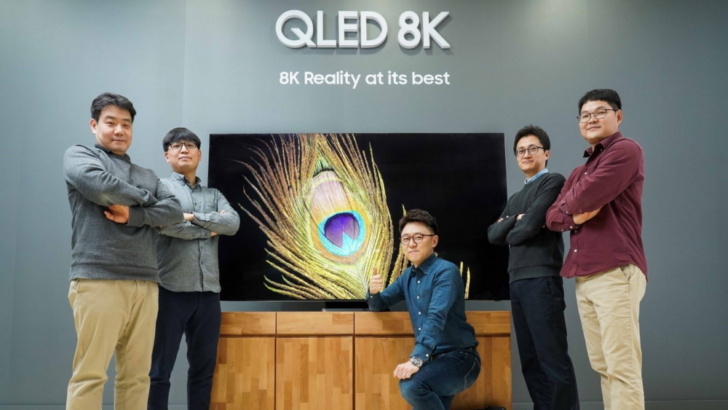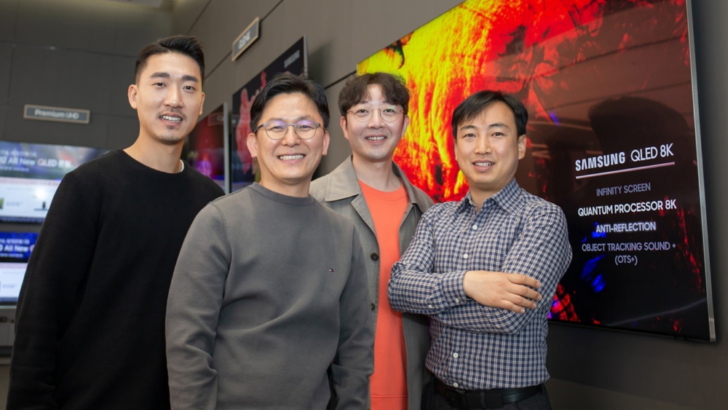[The Future of Viewing] ④ Innovative Sound Technologies, Powered by AI
on April 24, 2020
Now is the age of home entertainment. The concept of the modern ‘home’ goes way beyond being merely a residential space; it has become a place for relaxation, for recreation and for quality time with others. At the center of this change is the near-three-dimensional content experiences granted by today’s ultra-large, ultra-high definition, ultra-fine pixel TVs. Of course, high quality audio provides the finishing touch to such experiences.
With its 2020 QLED 8K TVs and AI sound technologies, Samsung has raised the bar for TV audio experiences. Object Tracking Sound+ uses AI-based software to match the movement of audio with movement on-screen; Active Voice Amplifier (AVA) tracks the user’s audio environment; and Q-Symphony creates a more realistic, three-dimensional sound.
Samsung Newsroom sat down with the sound developers of Samsung Electronics’ Visual Display Business to learn more about their extensive capabilities and the journey to fostering innovation in sound.

(From left to right) Youngtae Kim (Sound Lab), Jongbae Kim (Sound Lab), Yoonjae Lee (Sound Device Lab) and Sunmin Kim (Sound Lab)
Object Tracking Sound+: Reading the Room for More Realistic Audio Experiences
Action movies with amazing sound arrangements provide the most realistic experiences when experienced at movie theaters. This is because movie theaters have multi-channel speakers with 3D sound placed on almost all the walls (including the ceiling), as well as around the screen. Compared with two-channel sound that features speakers only on the left- and right-hand sides, the multi-channel speakers in a movie theater deliver a more refined sense of realism. So how can this realism be recreated in the home? Samsung’s sound developers came up with Object Tracking Sound+ technology, in which sound follows movement onscreen through six speakers built into the TV.
Thanks to this technology, a video’s audio follows the action on-screen in real time. When a car moves from the left to the right-hand side of the screen, so will the sound it makes; and when a heavy object drops from the top to the bottom of the screen, so will the audio.

When developing the 2020 QLED 8K TVs, Samsung’s TV developers increased the number of QLED TV speakers from two to six in order to realize sound that can mimic action. “By placing two speakers on each side of the screen, as well as on the top and bottom, we enabled the dissemination of sound in all directions from a total of six speakers,” explained Jongbae Kim. “The distance between the two main speakers has been widened as much as possible, and the additional speakers have been installed in order to maximize sound across all axes to be as three-dimensional as possible. For example, we placed speakers on the upper side of the screen to enable the movement of sound in a vertical direction for a more immersive sound experience.” Additionally, Kim highlighted how, despite the complex nature of a TV structure that includes six embedded speakers, the team managed to keep the design of the TV slim and minimal.
In order to ensure audio will follow on-screen movements accurately, it is important to understand the original intentions of content creators. “The role of a sound engineer is to increase the consistency between the action onscreen and its accompanying audio track when mixing. The location information of sound in a piece of video content, including sound panning information, is subsequently audio-signaled into the audio channel by the sound engineer – something we must be able to track in order to reproduce the location and movement of a content’s audio accurately,” noted Jongbae Kim. “Our Object Tracking Sound+ technology analyzes the location information contained in these audio signals as originally placed during mixing. This means the TV can then effectively distribute the sound amongst its six speakers by distinguishing between sound orientations and whether or not the audio source is on-screen, off-screen, close-up or distant.”
AVA: Intelligent Noise Detection to Enhance Voice Clarity
When that crucial scene in the show you are watching is overwhelmed by mixer sound or an important breaking news report is obscured by loud thunder, the act of reaching for the remote to adjust the TV’s volume can come too late. This is why the team developed their AVA technology, which recognizes exterior noises and increases the volume of voices in content accordingly if surrounding conditions become too loud.

The way it works is intelligent. The TV’s sound sensor, attached to the bottom middle of the TV, takes in audio from the content onscreen as well as its surrounding environs. AI technology then compares the volume levels of the two types of sound, and if external sounds are found to be louder than that of the TV’s content, it will selectively raise the TV’s volume. “The system does not have one set definition of noise,” explained Sunmin Kim. “It considers any and all elements that disturb enjoyment of content as noise. When exterior sounds persist above a certain decibel level, that is when the system registers it as ‘noise’.”
However, AVA technology does not just raise the volume of the TV when it recognizes a louder environment, as this would only contribute to a boisterous room experience. “The system harnesses AI to keep sound effect and background audio levels consistent and to only raise the volume of voice audio,” highlighted Sunmin Kim. “Our research showed us that the majority of content is dialogue-heavy, so we believe that enhancing the delivery of dialogue would be most beneficial to aid comprehension.”
Q-Symphony: Creating a Multi-Dimensional Soundscape
One of key elements to achieving a realistic sound during content playback on a TV is three-dimensionality, which encompasses both horizontal and vertical audio characteristics. Until recently, these perspectives had been being developed separately by the TV and Soundbar teams. However, with the inclusion of upper side speakers on Samsung’s 2020 QLED 8K TVs, the team developed an all-inclusive solution that utilizes the capabilities of both the TV and the soundbar in perfect harmony. Q-Symphony is a feature that plays audio using both the TV speakers and the soundbar at the same time, and as an industry first achievement, the Q-Symphony technology was even recognized with a Best of Innovation Award at CES 2020.

“The core of Q-symphony, which manages sound playback harmoniously using speakers with different characteristics, is technology that follows the sound playback rules which are determined in advance and exchanges the necessary information between the TV and the soundbar, when connected. This approach allows for a superior reproduced sound experience,” explained Yoonjae Lee. “A key element of the technology is a special algorithm that we created which divides and harmonizes sounds seamlessly between the TV’s speakers and soundbar.”
During development, challenge arose regarding the quality of dialogue reproduction. When both the soundbar and the TV speakers played dialogue simultaneously, the sound quality was noticeably diminished. However, the sound development team were able to resolve this issue by separating the main sound track, including dialogue, from the entire signal and assigning the different tracks to the TV speakers and soundbar respectively. “In the 2020 QLED 8K TV range, the voice signal is extracted and removed from the sound being reproduced by the TV’s embedded speakers, which are then assigned to play ambient sound signals such as sound effects,” explained Lee. “The soundbar then reproduces the main sound involving any dialogue. With this technology, Q-Symphony harnesses the advantages of both TV speakers and the soundbar in order to deliver the best, and most harmonious, sound experience to users.”
Working Together to Develop the Perfect Sound Experience
The sound development team agreed that realizing the addition of speakers, the new placement of speakers and the AI harmonization with the soundbar on the 2020 QLED 8K TV range was possible because of close coordination with a variety of other teams. “When developing new TVs, all areas need to be in sync with their innovations,” noted Youngtae Kim. “We came together in suggesting various solutions to overcome each and every technological hurdle with an open mind.”

Youngtae Kim (left) and Sunmin Kim introduce the innovative sound technologies of the 2020 QLED 8K TV range
The sound development team has always been and always will be dedicated to developing the best possible audio experiences for users. As well as working with Samsung’s Audio Lab based in the U.S. for the future audio technology, the team also works with Samsung Research’s R&D Centers, universities and start-up experts around the world. “We want to bring about sound experiences that are as natural and as real as possible,” explained Youngtae Kim. “To achieve this, we will continue to work hard to understand the end-to-end process of the sound and realize sounds in our TVs.”
Samsung’s sound innovation also helps to realize its vision of ‘Screens Everywhere’. “In the future, we will bolster the use of AI so that users do not even need to use a remote control to find the perfect audio balance when enjoying their favorite content,” said Sunmin Kim. “As time goes by, TV installation environments, lifestyles and age groups will be diversified. We want users to enjoy the sound of their content as intended, regardless of content type or listening environment.”


